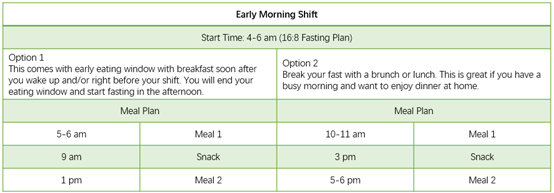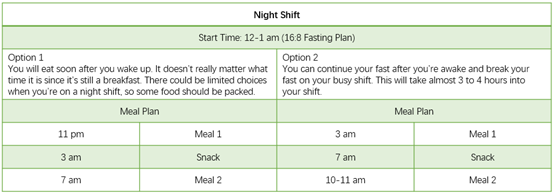Shift work is more prevalent today, not only in public sectors like healthcare and law enforcement but also in industries like hospitality and customer service. When deciding on an intermittent fasting regimen, your work schedule is important. For shift workers as opposed to 9–5ers, it is undoubtedly more challenging to select from the standard fasting diet. You will learn how to choose an appropriate fasting plan and some important difficulties with shift workers in this article.

What is Shift Work?
Generally speaking, shift work refers to any schedule that is not from 7 AM to 6 PM. As part of a compressed schedule, shift workers may work longer shifts that are >8.5 hours/>40 hours/week. Some common shift employees are:
How Shift Work Influences the Circadian Rhythm?
Shift workers undoubtedly benefit from having a day off on the weekdays, avoiding rush hour traffic, and greater compensation. But shift work, particularly night shifts, has a working schedule that is in conflict with the circadian rhythm, which disturbs the body’s homeostasis (the balancing system your body tries to maintain) and raises the risk for a number of health disorders, including:
How Circadian Rhythm Influences Sleep?
Circadian rhythms provide a crucial function by preparing your body for impending environmental changes including, for instance, the best times to be active, sleep, and eat. A crucial component of our bodies is sleep. The following syndromes can result from shift work’s disruption of circadian rhythms and influence on sleep patterns:
Of these three shift kinds, the one that occurs at night is most likely to have an impact (early morning, afternoon, and night shift). A healthy balance between wakefulness and sleep pressure leads to sleep. You will fall asleep when your sleep pressure remains higher than your wakefulness and get up when the pressure to get up beats that of sleep.
If the circadian system has not adapted to working at night and sleeping during the day, this will be an issue for a night shift worker. The circadian rhythms for wakefulness and the sleep pressure drives won’t be synced, thus they won’t cooperate. Because your sleep pressure continues to outweigh your wakefulness, you could feel sleepy at work.
So how do you alter your sleep schedule to synchronize? In general, staying up later or getting up early makes it easier to alter sleep schedules. This is due to the circadian pacemaker’s propensity to run for longer than 24 hours, which facilitates later bedtimes.
To alter sleep schedules so that you wake up or go to bed earlier, the secret is to start an external timing cue that tells your body’s rhythm pacemaker to encourage sleep. The most effective cue and tactic to reduce what can keep you up at night is the sun’s light/dark cycle:
How to Rebuild a Disrupted Circadian Rhythm?
Circadian rhythms are naturally occurring cycles that rise and fall throughout the course of a 24-hour day. They govern the biochemical, physiological, and behavioral activities of all living things. It regulates vital bodily processes, including hormone release, feeding patterns, and digestion, as well as sleepiness and wakefulness.
By planning your day around your shift schedule, you can restore a broken circadian rhythm. In the same way that you cycle between sleep and awake time, intermittent fasting notifies you when it’s time to eat and when it’s not. You can maintain a circadian rhythm and get used to your shift work schedule much more quickly if you choose an intermittent fasting regimen based on it.
How to do Intermittent Fasting for Shift Workers?
The circle may function differently for shift employees than for those who work from 9 to 5. As a result, including an IF regimen in a shift worker’s schedule can aid in reestablishing your personal circadian rhythm. Here is a basic how-to that will lead you to choose a fasting schedule. The process of planning a fast is the same for everyone.
Start with a suitable plan
You can choose the popular 16:8 method or 14:10 to start the intermittent fasting journey. Then if necessary gradually increase the intensity. The longer the fasting window, the more intense the fasting plan is.
Set your own eating and fasting window
As you adjust your windows, keep the following in mind:
- Decide on a wake-up time so you can go to work promptly.
- Work a hectic shift, do you? Fasting is advised during a hectic shift.
- When do you typically feel hungry? The best option is to schedule that time into your dining window.
- Your access to food. Do you have to make your own food or can you just buy it? You might need to cook your own meals if you scheduled your eating window for the wee hours or early dawn.
- In the SoonFasting app, consult your Coach if you’re unsure.
Planning your meals ahead during the eating period
You must decide how frequently and when to eat. A non-regular shift schedule can make it much easier for you to stick to the habit and eating window. Aim for two meals, plus one or two snacks. Generally speaking, you should have your last meal three to four hours before going to bed. Here are a few illustrations of three different shift work schedules that follow the 16:8 fasting regimen:



If none of these three possibilities appeal to you, use the processes outlined above to create a plan that is unique to you. Outside of those three alternatives, this will apply to any fixed shift. A night shift example is as follows:
- Select a 16:8 diet or another intermittent fasting strategy.
- Eating hours are from 12 am to 8 am and from 8 am to 12 am for fasting.
Wake-up time is 7-8 pm, and the shift begins at 9 pm.
I shall fast during my shift till “lunch.”
I start eating between 12 am and 8 am and am at my hungriest between 1-2 am.
For night shifts, prepare meals in advance or purchase them in advance. - Plan for the meals
12 am: Meal One
3 am: Snack One
6 am: Snack Two
8 am: Meal Two
Are There Any Other Tips for Intermittent Fasting for People Who Work Shifts?
Definitely Yes! To achieve better results of IF on shift work, think about the following things:
- Have a healthy diet: It is advisable to follow the Dietary Guidelines for Americans and ration your meals according to the USDA’s MyPlate model when it comes to what to eat when intermittent fasting. You can also adhere to other healthy diets, such as the Mediterranean Diet, the Flexitarian Diet, and several vegetarian diets, if necessary.
- Try to keep a fixed shift schedule: If you wake up at roughly the same time each day, your body will function at its best. On your working days, you can choose an awake time to leave for work right away if you have a set shift plan. then on weekends, rise at the same time. If you have worked many shifts, it is best to take a nap to make up for lost sleep during the weekend or go to bed early on working days.
- Adjust your fasting & eating window: You might occasionally need to adjust your eating and fasting periods during the week to accommodate your shift work. The simplest method to do this without impacting your results is to increase or decrease your window for fasting and eating by a few hours, and then return to your regular schedule the following day. The main rule is to adhere to a minimum daily fasting period of 12 to 14 hours. While you are adjusting your windows, follow your meal plan (the number of meals you will eat each day) to prevent overeating.
There is one thing for certain: Everybody is unique, thus not every fasting regimen will fit with your shift work schedule. Always make an effort to pay attention to your body, and check in frequently to see if the measures are helpful to you. In this manner, you’ll discover your preferred beat.
Bottom Line:
- A disturbed circadian rhythm in shift workers is linked to a wide range of health issues.
- A circadian rhythm can be rebuilt with intermittent fasting.
- Use the instructions below to create an intermittent fasting regimen for shift work.
- The development and maintenance of a circadian rhythm depend heavily on sleep; use the tips below to help you alter your sleep schedule and get better-quality slumber.
- Keep your attention on healthy eating as usual or any other healthy diet you may practice.
- Adapt your strategy to your needs and schedule.
References: